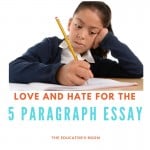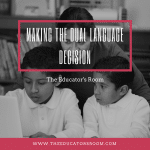Overview:
Writing in reverse is a strategy that encourages students to actively retrace a writer’s steps backward through the essay-writing process.
In the high school English classroom, one assessment continues to reign supreme: the essay. Informative, argumentative, and narrative essays have stood the test of time and for good reason. Essays allow students to showcase a multitude of skills across the common core, from research to literary analysis, creative writing to conventions. Not to mention the metacognitive skills of essay-planning as students analyze their prompt, brainstorm, research, outline, write, and revise. But what if, instead of writing from start to finish, we wrote in reverse?
What is Writing in Reverse?
Writing in reverse is a strategy that encourages students to actively retrace a writer’s steps backward through the essay-writing process, from the final draft to the essay’s prompt. First, students study an essay and break it down into a detailed outline. After outlining, students craft a prompt which they believe the essay responded to. Identifying a writer’s main point, delineating their line of thinking, and understanding their reasoning emphasizes the critical role each of those elements plays in the student’s writing.
This strategy is not only a skill-booster but also a boost to confidence and creativity. Students are able to see the variety of essays a single prompt can elicit, which encourages them to trust in their ability to answer any prompt, build an outline, and link ideas together in an essay without doubting their instincts.
The Basic Steps of Writing in Reverse
Step 1. After reading the essay, students determine the essay type: informative/explanatory, argumentative, or narrative. This will inform their outline and prompt!
Step 2: Next, students analyze the essay and identify its key elements, such as the thesis or claim statement, topics of body paragraphs, cited evidence, and supportive analysis. This is a great place to lay a foundation for practical annotation strategies!
Step 3: Then, students build a detailed outline based on the first two steps. Encourage the classic Roman numeral style and short, brief statements to encapsulate big ideas rather than transferring entire sentences from the essay into their outline.
Step 4: Finally, students write a prompt! This is a small yet complicated step, and one which requires the most metacognition. If the essay is the answer, what was the question? Ask students to apply at least one action verb in their prompt which they believe the essay accomplished, like argue, explain, summarize, or evaluate.
How Does This Increase Student Outcomes?
I often begin writing units with this exercise because it allows students to evaluate a strong mentor text as an example of what a successful essay might look like. This exercise is also helpful when addressing common writing errors or reinforcing learning scaffolds.
For example, about halfway through the school year, I noticed that the quality of essays in my sophomore English class was declining. Upon investigation, I found that students were neglecting critical steps in the writing process, often jumping straight to their introduction paragraph, which resulted in meandering and lengthy essays that lacked structure and focus.
Because this was an issue for a majority of students, I began our next summative writing assessment with the writing in reverse strategy. I printed two different mentor essays and divided them among six student groups. First, students completed steps one and two individually, then collaborated in their small groups on steps three and four.
The discussion around converting the mentor essay to an outline resulted in students reinforcing the critical elements of essay-writing, like, “Where is this writer’s thesis? It should be at the top, in the introduction paragraph,” or, “That can’t be the topic of the second paragraph because we decided it’s the topic of the third.”
Similarly, student collaboration around creating a prompt elicited key conversation about the essay’s purpose: “We shouldn’t use the verb argue because they’re actually describing something. What about evaluate?”
Each group wrote its outline and prompt on a large piece of chart paper and displayed its work around the room for a gallery walk. Students evaluated the outlines and prompts produced by peers with the same mentor essay and took notes of key similarities and differences. Then, in groups of three students from each group with the same essay, students shared their observations and reflected on the changes they would apply to their upcoming essay.
After implementing the writing-in-reverse strategy, I saw an increase in student agency and success throughout the essay-writing process because they no longer viewed the writing process steps as redundant tasks to be skipped over.
Why Write in Reverse?
The skills of essay writing don’t only serve a practical purpose. Often overlooked but equally important are the twenty-first-century skills gained from essay-writing that students will use nearly every day in their adult lives as they wade through the news with their morning coffee, decide whom to vote for, resolve conflicts with loved ones, or frantically google ways to help their newborn sleep in the middle of the night. Essays support media literacy, collaboration, problem-solving, adaptability, analytical thinking, creativity, innovation–the list goes on.
I would be remiss if I did not mention that many standardized tests (looking at you, SBAC) apply the writing in reverse strategy to their style of questions. If a student has little experience forecasting an essay’s argument based on the claim or selecting the strongest introduction based on the conclusion, then they may struggle with this reverse-thinking.
When we consider the hallmarks of accomplished teaching, like encouraging student self-efficacy, offering choice, self-reflection, and fostering a positive and collaborative environment where students are a part of a learning community that encourages risk-taking and exploration, this exercise accomplishes those things, and more!
Alternate Essay Exercises
Writing in reverse is really just a blanket term for playing with the order in which we teach writing, and it can take many different and exciting forms! Here are other writing exercises that you can add to your teaching toolkit and spice up the writing process.
The Fifth Step: As an extension to the four-step strategy detailed above, consider step five: students write a new essay in response to their own prompt that they constructed during the exercise. This would replace writing in response to a teacher-provided prompt.
Fill-in-the-Paragraph: Provide students with a nearly-complete mentor essay that is missing either a conclusion or introduction paragraph and ask them to write one. To simplify this further, you could ask students to craft a missing thesis or claim for the introduction paragraph to a completed essay.
Guided Research: Give students a mentor essay that only provides a single topic sentence for each body paragraph, missing the evidence and supportive analysis. Ask students to conduct their own research, cite their own evidence, and craft the supportive analysis for each body paragraph in a way that aligns with the purpose of the essay. To simplify the research step, you could also provide them with a works cited page and have them cite evidence from each source.
Red-light Green-light: Provide groups of approximately four-five students with a prompt and offer them ample time to brainstorm. Ask them to begin writing their essay until they hear a sound of your choosing–I might select an upbeat song to keep this exercise light and reduce anxiety–at which point, they pass their essay to the left. Continue this process until essays are complete, preferably when they arrive back at the original author. Give students an opportunity for structured reflection as they read through their essay, then share their expectations and outcomes in a discussion. Positive classroom culture is key! Students must be comfortable learning and being vulnerable together to get the most out of this exercise.
How to Roll This Out!
So, you’re interested in trying this strategy but aren’t sure how to begin rolling it out? Start small! Practice one step at a time, treating each one as its own lesson. Once students do this full process thoroughly and with guidance, they will become more independent and skilled as they gain more experience. You’ve got to go slow to go fast!
Begin with a lesson on examining and annotating an essay to determine its style and purpose. with a list of guiding questions to help your students through the process. They are detectives aiming to uncover the key characteristics of this essay, what kinds of questions should they be considering while annotating? Things like: “In the introduction, is there a claim statement or a thesis? How do I know?” “What are the topics of each body paragraph?”
Then, provide your whole class with the same strong sample essay and use the “I do, you do, we do” strategy. Model for your students using this strategy, taking them through every phase of the process, from reading the essay and making minor annotations to examining the essay in the context of the guiding questions. Intermittently, pause and guide your students to model themselves. For example, you can model with the introduction and first body paragraphs; then your students can take the second and third body paragraphs independently and come together as a class to discuss. Together, you complete the conclusion paragraph as a class and discuss.
Now that students have this model distribute the two to three mentor essays that you would like them to write in reverse. Ask them to annotate either in small groups or pairs when you are first rolling this out. Their collaboration will likely take them further than they could go on their own!
Treat the next two phases of the writing in reverse strategy, outlining and writing a prompt, with this much focus the first time through. Model in a way that students now have an example to use in the future, and encourage them to work in pairs or small groups to complete the outline and prompt. I would not recommend having your students collaborate on writing an essay in response to their new prompt, as this would be a great launching point for you to formatively assess their skills as the pre-assessment to the writing unit.
This will be a wonderful strategy for students to understand the purpose of the steps of the writing process, as well as build their metacognitive and social-emotional learning toolkits as they work together to crack the codes of these essays!







Great resource for teachers, Christine! With your specific and effective strategies, you help your students become strong writers.